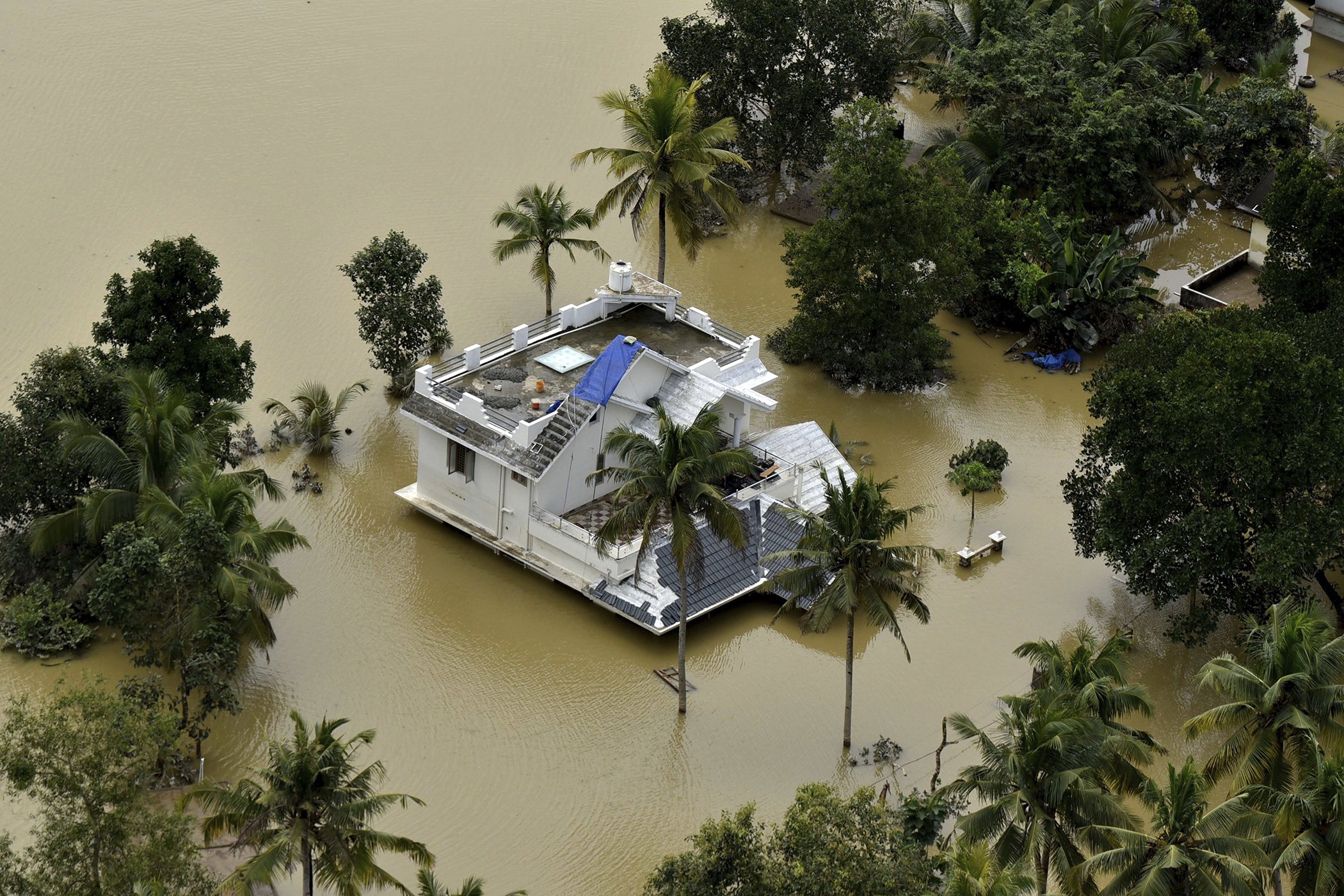From Indonesia to California, communities around the world faced many climate change-related challenges this year. Natural disasters have displaced entire communities, affecting their ability to grow food, access clean water and basic sanitation, and attend school.
Severe storms and flooding that devastated communities in southeast of the US, India, and the Philippines were followed by wildfires in California that destroyed thousands of home and took a record number of lives.
While natural disasters pose a threat to all humans, those living in poverty are often more likely to live in the path of a storm and lack adequate resources to recover in the aftermath.
Serious action is needed to prepare communities for future extreme weather events and to mitigate the impacts of climate change already seen this year.
These are some of the most heartbreaking natural disasters of 2018.
 A house is partially submerged in flood waters in Chengannur in the southern state of Kerala, India, Aug.19, 2018. Some 800,000 people have been displaced and over 350 have died in the worst flooding in a century.
A house is partially submerged in flood waters in Chengannur in the southern state of Kerala, India, Aug.19, 2018. Some 800,000 people have been displaced and over 350 have died in the worst flooding in a century.
1. Unprecedented Flooding in Kerala, India
Kerala's floods, described as the state's "worst in 100 years," displaced more than 1 million people and killed at least 445 in August. The region saw an unprecedented amount of rainfall — 164% more than usual — during the first 20 days of the month, according to NASA. While flooding in Kerala is not uncommon during monsoon season, some have pointed to climate change as an exacerbating factor in these year's devastating rains. Experts have also linked the extent of the damage to poor water management and deforestation, highlighting a dire need for policies that will protect people and the environment moving forward.
Read More: Floods in Kerala, India, Show How Unprepared the World Is for Climate Change
 Earthquake survivors spend their afternoon outside their tents in Palu, Central Sulawesi, Indonesia, Tuesday, Oct. 9, 2018. A 7.5 magnitude earthquake rocked Central Sulawesi province on Sept. 28, triggering a tsunami and mudslides that killed a large number of people and displaced tens of thousands of others.
Earthquake survivors spend their afternoon outside their tents in Palu, Central Sulawesi, Indonesia, Tuesday, Oct. 9, 2018. A 7.5 magnitude earthquake rocked Central Sulawesi province on Sept. 28, triggering a tsunami and mudslides that killed a large number of people and displaced tens of thousands of others.
2. Earthquakes and a Tsunami in Indonesia
Located in an area of high tectonic activity, Indonesia faces constant threats of earthquakes, tsunamis, and volcanic eruptions, but this year, the country was plagued by multiple natural disasters.
A 7.2-magnitude earthquake shook the island of Sulawesi, triggering a tsunami that killed more than 2,000 people in early October. This came just weeks after a powerful earthquake hit the island of Lombok, leaving more than 20,000 Indonesians homeless and killing more than 100 people. Despite frequent extreme weather events, Indonesia allocates just 0.002% of its total budget to disaster preparation and recovery funds. But as sea levels rise, island nations, like Indonesia, are becoming more and more vulnerable to the effects of climate change and extreme weather events.
Read More: Deadly Indonesia Earthquake Leaves 20,000 People Homeless
 High winds and storm surge from Hurricane Florence hits Swansboro N.C.,Friday, Sept. 14, 2018.
High winds and storm surge from Hurricane Florence hits Swansboro N.C.,Friday, Sept. 14, 2018.
3. Hurricane Florence Struck the Carolina Coast
In the southeast of the United States, Hurricane Florence devastated communities this September. Florence was not only an example of a storm intensified by climate change, it was a reminder of climate change's unequal burden on people living in poverty and the economic barriers to seeking safety during a natural disaster.
Over 1 million people were ordered to evacuate across the Carolina Coast; however, many low-income residents in Myrtle Beach, South Carolina could not afford to evacuate before the hurricane hit. Myrtle Beach, one of the areas struck hardest by Florence, has a poverty rate of 23% as compared to an average of 14.5% across the US. Like Hurricanes Katrina and Harvey, Florence disproportionately impacted communities of color.
Read More: Not Everyone Can Afford to Evacuate for Hurricane Florence
 A resident stands on the roof of her house on Sept 17, 2018 in in Calumpit township, Bulacan province north of Manila, Philippines, amidst flooding brought about by Typhoon Mangkhut which barreled into northeastern Philippines during the weekend.
A resident stands on the roof of her house on Sept 17, 2018 in in Calumpit township, Bulacan province north of Manila, Philippines, amidst flooding brought about by Typhoon Mangkhut which barreled into northeastern Philippines during the weekend.
A resident stands on the roof of her house on Sept 17, 2018 in in Calumpit township, Bulacan province north of Manila, Philippines, amidst flooding brought about by Typhoon Mangkhut which barreled into northeastern Philippines during the weekend and inundated low-lying areas.
4. Typhoon Mangkhut Hit the Philippines
Many storms destroyed communities around the world this year, but Typhoon Mangkhut proved to be 2018's strongest storm — with the intensity of a Category 5 hurricane. The Super Typhoon struck the Philippines on Sept. 15 and then made its way to Hong Kong and mainland China, causing floods and landslides that claimed more than 125. For low-income families living in poorly maintained public housing and makeshift shelters before the typhoon, recovery has been especially challenging. They have continued to feel the devastation of the storm months after it passed.
Read More: Dozens Dead as Typhoon Mangkhut Strikes the Philippines, Hong Kong, and Chin
 Rescue personnel search amidst debris in the aftermath of Hurricane Michael in Mexico Beach, Fla., Oct. 11, 2018.
Rescue personnel search amidst debris in the aftermath of Hurricane Michael in Mexico Beach, Fla., Oct. 11, 2018.
Rescue personnel search amidst debris in the aftermath of Hurricane Michael in Mexico Beach, Fla., Oct. 11, 2018.
5. Hurricane Michael in the Florida Panhandle
Hurricane Michael made landfall in the Florida Panhandle on Oct. 10 as the third strongest hurricane in US history and the strongest the Gulf Coast had ever seen. The storm, which wreaked havoc on coastal towns and took at least 36 lives, was fueled by abnormally warm water temperatures caused by fossil fuel production, according to experts.
Human activity, like extracting fossil fuel, has contributed to climate change and global warming. Climate change, in turn, poses a major threat to coastal communities and people living in poverty as warming oceans continue to breed more dangerous storms. Hurricane Michael hit Panama City's working poor, who lacked the resources to prepare, were hit hardest by the storm, Miami New Times reports.
Read More: How Climate Change Made Hurricane Michael More Destructive
 Residences leveled by the Camp Fire line a cul-de-sac in Paradise, Calif., on Thursday, Nov. 15, 2018. The California Department of Forestry and Fire Protection said Thursday the wildfire that destroyed the town of Paradise is now 40 percent contained, up from 30 percent Wednesday morning.
Residences leveled by the Camp Fire line a cul-de-sac in Paradise, Calif., on Thursday, Nov. 15, 2018. The California Department of Forestry and Fire Protection said Thursday the wildfire that destroyed the town of Paradise is now 40 percent contained, up from 30 percent Wednesday morning.
6. Deadly Wildfires in California
In November, three wildfires ravaged California. One fire in particular, Camp Fire, raged for 17 days in Paradise, California, killing at least 85 people and leaving hundreds missing and thousands more displaced. The fire is now the deadliest wildfire in the state's history.
Fire season has come to take on new meaning in California where wildfires have become more frequent and destructive. Nine of the state's 20 most destructive fires have taken place in the past three year following prolonged drought. Experts say this trend is being fueled by climate change. Th wildfires have disproportionately impacted people of color and low-income residents, often overlapping demographics in the US.
According to a recent study comparing 70,000 census tracts across the country, areas that are majority Black, Hispanic, or Native American are 50% more vulnerable to wildfires, as these communities have limited access to resources to pay for insurance, rebuilding homes and infrastructure, and low funding for fire safety. In the aftermath of the wildfire, many have been living in tents in parking lots as they await space in shelters.
Read More: 15 Photos of California's Wildfires That Show the Devastation of Climate Change





